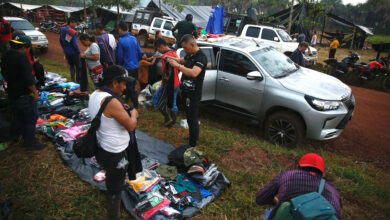A year on from a coup that plunged Myanmar into violence spiral

Bangkok, January 27 (EFE).- Myanmar celebrates one year Tuesday under the yoke of the military regime that took power on Feb. 1 and ended the democratic government of Aung San Suu Kyi citing alleged electoral fraud during the 2020 elections.
The coup was met with a massive citizen opposition movement. The military repressed it with extreme harshness and plunged the country into a spiral of violence, in addition to sinking its economy and isolating itself from the international community.
Below is a chronology of the key moments that have marked the dictatorship of the military junta during its first year.
The military came out of the barracks the morning of Feb. 1 and took control of Naypyidaw after arresting the main political leaders elected in the November 2020 elections.
The deposed de facto leader of the Myanmar government Aung San Suu Kyi and ousted President Win Myint along with the rest of the parliamentarians, were in the capital, where they were going to be sworn in that morning for the next four years.
After the first 48 hours of tension, on Feb. 3 workers in the health sector began an indefinite strike and refused to collaborate with the newly formed military junta.
This protest increased as the days went by and led to the Civil Disobedience Movement, which has managed to stop the operation of part of the administration.
On Feb. 6, more than 20,000 people gathered in the historic center of Yangon, the former capital and most populous Myanmar city, to express their rejection of the military command and demand the release of Suu Kyi and the rest of the civilian leaders.
Opposition sentiment spread like wildfire throughout the nation and in a matter of days practically the entire country registered massive marches against the military, who soon began to use violence to placate the crowd.
Mya Thwe Thwe Khine, 20, died on Feb. 19, becoming the first fatality of the military junta’s crackdown.
The young Myanmar woman died in a Naypyidaw hospital after spending ten days in critical condition after being shot in the head on Feb. 9 while she was participating in a protest against the military dictatorship.
A year after the coup, the number of fatalities as a result of the repression of the authorities is about 1,500 dead, according to data from the country’s Association for the Assistance of Political Prisoners NGO.
At least 82 people were killed on Apr. 9 when security forces attacked a protesters’ camp in the city of Bago, 60 kilometers east of Yangon.
Soldiers and police used large-caliber weapons and explosives against protesters, during this massacre which is among the bloodiest days since the coup.
On Apr. 16, ousted politicians and pro-democracy activists announced the formation of the self-styled National Unity Government, loyal to Suu Kyi, with which to stand up to the military junta.
The group, which operates clandestinely to avoid repression by the junta, defines itself as the legitimate representative of the Myanmar people, a recognition that has so far been elusive by other nations and international institutions.
The shadow government announced on May 5 the creation of its armed wing, the People’s Defense Force, with the aim of launching an armed revolution against the military junta, who classifies them as “terrorists.”
After more than three months under military arrest, Suu Kyi appeared on May 24 before a court of law where she was formally charged with various crimes.
Military-controlled public television broadcast footage of Suu Kyi in the dock during her appearance, her first public appearance since the coup.
On September 7, after sporadic skirmishes with the Armed Forces, the resistence government declared a “defensive war” against the military junta and incited popular rebellion.





